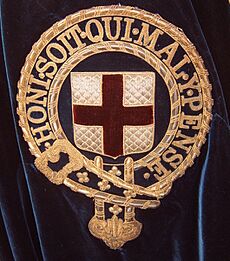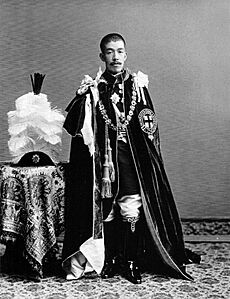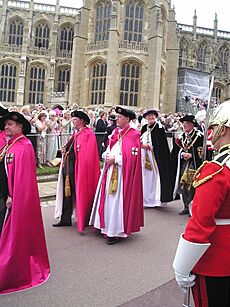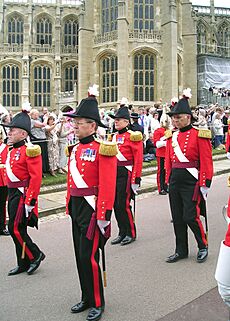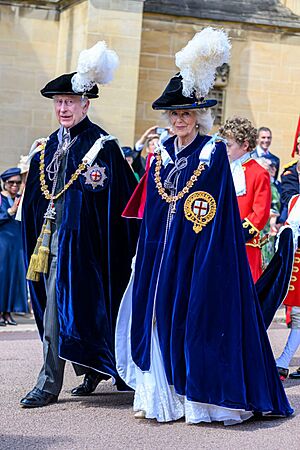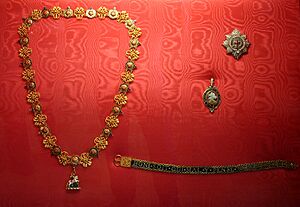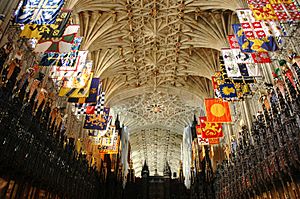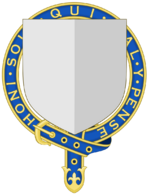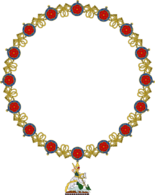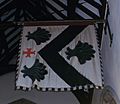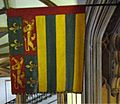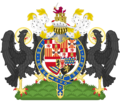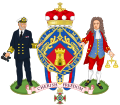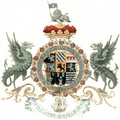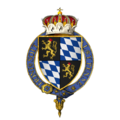Order of the Garter facts for kids
Quick facts for kids Most Noble Order of the Garter |
|
|---|---|
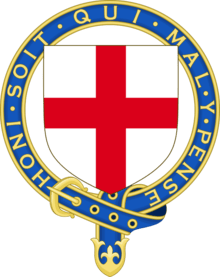
Badge of the Order of the Garter:
The attributed arms of Saint George circumscribed by the Garter |
|
| Awarded by the Monarch of the United Kingdom |
|
| Type | Dynastic order |
| Established | 1348 |
| Motto | Honi soit qui mal y pense (Anglo-Norman for 'Shame on him who thinks evil of it') |
| Criteria | At the monarch's pleasure |
| Status | Currently constituted |
| Founder | Edward III |
| Sovereign | Charles III |
| Chancellor | The Baroness Manningham-Buller |
| Prelate | The Bishop of Winchester (ex officio) |
| Classes |
|
| Statistics | |
| First induction | 1348 |
| Total inductees |
|
| Precedence | |
| Next (higher) | George Cross |
| Next (lower) | Order of the Thistle |
Ribbon of the Order of the Garter |
|
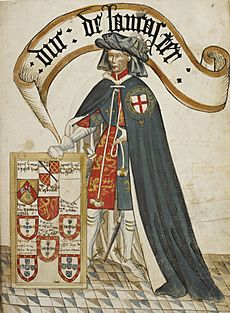
The Most Noble Order of the Garter is a very old and important group of knights and ladies. It was started by King Edward III of England in 1348. This Order is the highest award for bravery and service in the United Kingdom. Only the Victoria Cross and the George Cross are considered more important. The Order of the Garter is special because it is dedicated to Saint George, who is England's patron saint.
The King or Queen of the UK chooses who gets to join the Order. They usually pick people who have done great things for the country or for the Royal Family. There can only be 24 regular members, called Companions, at one time. The King or Queen is always the leader, called the Sovereign of the Garter. The Prince of Wales is also always a member. There are also extra members, like other members of the British royal family and kings and queens from other countries.
The symbol of the Order is a garter (a band worn around the leg). It has the motto Honi soit qui mal y pense written on it in gold. This means "Shame on him who thinks evil of it" in an old French language. Members wear this garter and other special items during important ceremonies.
Contents
History of the Order
King Edward III created the Order of the Garter around 1348. This was when he was trying to claim the throne of France. Some records suggest it might have started a few years earlier, but 1348 is the official date. When it began, all members had to be knights already. The idea for the Order might have come from a similar group in Spain called the Order of the Band.
First Knights of the Garter
When the Order was founded, it included King Edward III and 25 other knights. These knights are known as the Founder Knights. They are listed below in the order of their special seats in St George's Chapel:
- King Edward III (1312–77)
- Edward the Black Prince, Prince of Wales (1330–76)
- Henry of Grosmont, 4th Earl of Lancaster (c. 1310–61)
- Thomas de Beauchamp, 11th Earl of Warwick (1313–69)
- Jean de Grailly, III Captal de Buch (d. 1376)
- Ralph de Stafford, 1st Earl of Stafford (1301–72)
- William de Montacute, 2nd Earl of Salisbury (1328–97)
- Roger Mortimer, 2nd Earl of March (1328–60)
- John, 2nd Baron Lisle (1318–55)
- Bartholomew, 2nd Baron Burghersh (c. 1329–69)
- John, 1st Baron Beauchamp (d. 1360)
- John, 2nd Baron Mohun (c. 1320–76)
- Sir Hugh de Courtenay (1327–49)
- Thomas Holland, 1st Earl of Kent (1314–60)
- John, 1st Baron Grey de Rotherfield (1300–59)
- Sir Richard Fitz-Simon (1295–1348/49)
- Sir Miles Stapleton of Bedale (c. 1320–64)
- Sir Thomas Wale (1303–52)
- Sir Hugh Wrottesley (d. 1381)
- Sir Nele Loring (1320–86)
- Sir John Chandos (c. 1320–69)
- Sir James Audley (c. 1318–69)
- Sir Otho Holand (c. 1316–59)
- Sir Henry Eam (d. before 1360)
- Sir Sanchet D'Abrichecourt (c. 1330–59)
- Sir Walter Paveley (1319–75)
Pictures of all these knights can be found in the Bruges Garter Book, which was made around 1431.
Stories About the Order's Start

There are many stories about how the Order of the Garter began. The most famous one is about the "Countess of Salisbury." The story says that her garter fell off while she was dancing at a ball. When people around her laughed, King Edward III picked it up. He then said, "Honi soit qui mal y pense", which means "Shame on him who thinks evil of it." This phrase became the Order's motto. However, this story was first written down much later, in the 1460s. It was probably made up to explain why a garter, which was seen as women's clothing, became the symbol for a group of knights. Actually, in the 1300s, garters were mostly worn by men.
Another story says that King Richard I was inspired during the Crusades to tie garters around his knights' legs. This was supposed to help them win a battle. King Edward III then remembered this story when he started the Order.
The motto actually refers to King Edward's claim to the French throne. The Order of the Garter was created to help him with this claim. The garter itself might have come from straps used on armor. It could also have been chosen because it sounded like a "band" or "bond" of knights who supported Edward.
Ladies of the Garter
For a while after the Order started, women were also part of it, called "Ladies of the Garter." The first was Queen Philippa in 1358. However, King Henry VII stopped this practice in 1488.
Later, in the 20th century, queens like Queen Alexandra, Queen Mary, and Queen Elizabeth were made Ladies of the Garter. Princess Elizabeth (who later became Queen Elizabeth II) also became a Lady of the Garter before she became Queen.
In 1987, Queen Elizabeth II made a new rule. This rule allowed women to become full "Ladies Companion of the Garter." This means they are now equal members. For example, Queen Camilla was made a Royal Lady of the Garter by Queen Elizabeth II. In 2022, Valerie Amos, Baroness Amos, became the first Black Lady Companion. In 2024, Eliza Manningham-Buller, Baroness Manningham-Buller, became the first Lady Companion to be the Chancellor of the Order.
Who Belongs to the Order?

Members of the Order
Membership in the Order is very limited. It includes the Monarch, the Prince of Wales, and no more than 24 other members called "Companions." The Monarch is the only one who decides who gets to join. The Monarch is known as the Sovereign of the Garter. The Prince of Wales is a Royal Knight Companion.
Male members are called "Knights Companion," and female members are called "Ladies Companion." For a long time, the Monarch would choose new members based on suggestions from the current members. However, since 1953, the Monarch chooses members all by themselves.
Since 1946, the Monarch has personally chosen Knights and Ladies Companion. They do this without any advice from the government. New members are usually announced on Saint George's Day, which is April 23.
Extra Members
The Order also has "supernumerary" members. These members don't count towards the limit of 24 Companions. Some of these are "Royal Knights and Ladies of the Garter," who are members of the royal family. King George III created these roles in 1786 so that his many sons could join without taking up spots from other people.
Foreign kings and queens can also become supernumerary members. They are called "Stranger Knights and Ladies of the Garter." For example, Emperor Alexander I of Russia became a member in 1813.
Removing Members from the Order
The Monarch can remove members who have fought against the Crown. In the past, there was a special ceremony to remove a knight. During this ceremony, the knight's banner, helmet, and sword were taken down from St George's Chapel. They were then thrown into the castle ditch. The last time this formal ceremony happened was in 1716.
During the First World War, some foreign monarchs and princes from enemy countries, like Kaiser Wilhelm II of Germany, were removed from the Order in 1915. Emperor Hirohito of Japan's banner was removed during World War II. However, his knighthood and banner were given back by Queen Elizabeth II in 1971 when he visited the UK.
Officers of the Order
The Order has six special officers who help run it:
- The Prelate is always the Bishop of Winchester.
- The Chancellor is now one of the Order's members. For a long time, the Bishop of Salisbury or the Bishop of Oxford held this job.
- The Register has been the Dean of Windsor since 1558.
- The Garter Principal King of Arms is the main officer of the College of Arms. They look after the coats of arms and banners of the members.
- The Usher is also known as the Usher of the Black Rod. They work for the House of Lords.
- The Secretary helps the Garter Principal King of Arms.
Here are the current officers:
- Prelate: Philip Mounstephen, Bishop of Winchester (since 2023)
- Chancellor: Eliza Manningham-Buller, Baroness Manningham-Buller (since 2024)
- Register: Christopher Cocksworth, Dean of Windsor (since 2023)
- King of Arms: David White, Garter Principal King of Arms (since 2021)
- Secretary: Lieutenant Colonel Stephen Segrave (since 2024)
- Usher: Lieutenant General Ed Davis, Gentleman Usher of the Black Rod (since 2025)
Military Knights of Windsor
When the Order of the Garter was founded, there were 26 "poor knights" who were connected to the Order. They were supposed to pray daily for the Knights Companion. In return, they received a salary and a place to live in Windsor Castle.
These knights were often military veterans who had become poor. In the 19th century, King William IV changed their name to the Military Knights of Windsor. They are no longer necessarily poor, but they are still military pensioners. They take part in the Order's processions and chapel services, but they are not considered full members of the Order.
The Military Knights used to wear red robes. Now, they wear an old military uniform. It includes black trousers with a red stripe, a red coat, gold shoulder decorations, a special hat with a feather, and a sword.
Robes and Special Items
What Members Wear
For special events like the annual Garter Day, members wear very fancy clothes and items:
- The mantle is a long robe made of dark blue velvet. It is lined with white silk. The Monarch's mantle and those of Royal Knights and Ladies have long trains. On the left shoulder, there is a shield with St George's Cross surrounded by the Garter.
- The hat is a black velvet hat with white ostrich and black heron feathers.
- The collar is worn around the neck over the mantle. It is made of gold and has gold knots mixed with medallions. Each medallion shows a rose surrounded by the Garter. This rose is the Tudor rose, which combines the red rose of Lancaster and the white rose of York.
- The Great George hangs from the collar. It is a colorful figure of Saint George on horseback fighting a dragon.
- The Garter is worn on the left calf by knights and on the left arm by ladies. It is a dark-blue velvet strap with the motto in gold letters.
For other less formal occasions, members wear simpler items:
- The collar is worn on special "collar days" over military uniform or formal day wear.
- The star is pinned to the left side of the chest. It is a silver eight-pointed star with a colorful shield of St George's Cross surrounded by the Garter in the middle.
- The riband is a wide blue sash worn over the left shoulder. Its color is called "kingfisher blue."
- The badge is a smaller, flatter gold version of the Great George. It is worn hanging from the riband on the right hip.
When a member dies, some of their special items are returned to the Monarch or to the Order's office.
What Officers Wear
For ceremonies, the officers of the Order also wear special clothes:
- The Prelate and Chancellor wear dark blue mantles, like the members. The other officers wear dark red mantles. All mantles have a shield with St George's Cross.
- Officers wear special badges around their necks. Each badge shows a symbol related to their job, surrounded by the Garter. For example, the Prelate's badge has a bishop's hat.
- The Chancellor carries a special purse with the Order's seal inside. The Usher carries a black staff called the Black Rod.
The Chapel
St George's Chapel in Windsor is the main church for the Order of the Garter. Special services for the Order are held there.
While they are alive, all members of the Order can display their family's coat of arms and banners in St George's Chapel. When a knight or lady dies, their banners are removed from the chapel. Sometimes they are given to places connected to the person, or kept by their family.
There are also special "Garter stall plates" in the chapel. These are small, decorated brass plates that stay in the chapel forever to remember the Knights of the Garter.
Joining the Order
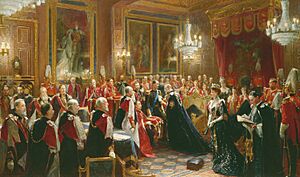
Every June, on Garter Day, members of the Order meet at Windsor Castle. If new Knights or Ladies are joining, a special ceremony called an investiture is held in the Throne Room. All available members attend this ceremony in their robes. New members take an oath and are given their special items.
After the ceremony, there is a special lunch. Then, all the knights, ladies, and officers walk in a procession through the castle to St George's Chapel for a worship service. During this service, the new members are formally installed.
The formal installation ceremony in St George's Chapel stopped in 1805. But it was brought back in 1948 to celebrate the Order's 600th anniversary.
Special Privileges
Order of Importance
Members of the Order of the Garter have a very high place in the order of importance in the UK. They come before almost all other knights and baronets. The wives, sons, daughters, and daughters-in-law of Knights Companion also get a higher place.
Knights Companion can use "Sir" before their first name (e.g., Sir John). Ladies Companion can use "Lady" before their first name (e.g., Lady Mary). Wives of Knights Companion can use "Lady" before their husband's last name. However, these titles are not used by royalty or peers.
Members also use special letters after their name: "KG" for Knights Companion and "LG" for Ladies Companion. These letters are usually placed before any other awards they might have, except for a few very high honors like the Victoria Cross or George Cross.
Family Symbols
In their family symbols (like a coat of arms), members of the Order of the Garter can draw the Garter around their shield. Knights and Ladies Companion are also allowed to have heraldic supporters (animal or human figures holding up the shield) in their coat of arms. This is a special privilege that only a few people, like members of the Royal Family and peers, are allowed.
Gallery
-
Garter banner of Alexander Baring, 6th Baron Ashburton, now in Winchester Cathedral
-
Garter banner of Oliver Lyttelton, 1st Viscount Chandos, now in St John the Baptist Church, Hagley
-
Garter banner of Lord Wilson of Rievaulx, now at Jesus College Chapel, Oxford
-
Garter banner of Henry Manners, 8th Duke of Rutland, now at Belvoir Castle
-
Arms of Philip, Prince of Asturias at his investiture, encircled by the Garter (in 1554)
-
The arms of John Churchill, 1st Duke of Marlborough, are encircled by both the Garter and the collar.
-
The Garter "Star" worn by King Charles XI of Sweden, late 17th century
-
The garter of Emperor Franz Joseph I of Austria
Armorial Bearings
| The Order's Symbols | |
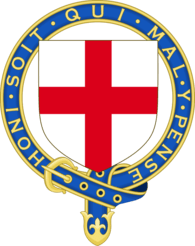 |
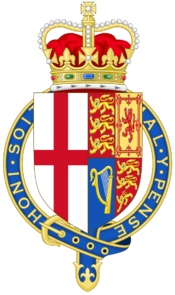 |
| The Order's own coat of arms | A version with the royal arms and St Edward's Crown |
More to Explore
- List of current knights and ladies of the Garter
- List of knights and ladies of the Garter
See also
 In Spanish: Orden de la Jarretera para niños
In Spanish: Orden de la Jarretera para niños


